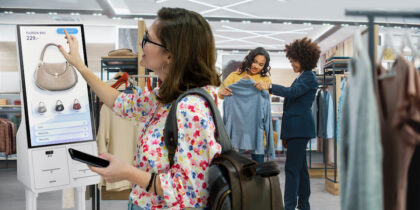They’re calling it the retail apocalypse, with long-established brands closing hundreds of brick-and-mortar outlets. J.C. Penney, RadioShack, Macy’s and Sears have each said they plan to close more than 100 stores, The Atlantic reported. The sector is hemorrhaging jobs, shedding over 30,000 positions in March after losing 26,000 jobs in February.
Analysts say the run of bad news should come as a wake-up call. Battered by online competition, they argue, traditional retail needs to significantly upgrade its in-store technology if it is going to remain competitive. “E-commerce has gone from being a distraction to being a sledgehammer that is really hurting the retail industry,” says Doug Stephens, analyst and founder of Retail Prophet. “Stores need to up their game, and they do that by using technology to better understand the consumer’s experience.”
Customers today expect convenience, ease and personalization. Technology that can deliver these “will be increasingly key to physical store success,” says Sara Al-Tukhaim, vice president of global retail insights and operations at Kantar Retail. “This includes technologies that enable more personalized solution-selling, targeted and localized inventory decisions, streamlined checkout processes, mobile-integrated experiences and overall ease of any time, anywhere purchasing,” she says.
Brick, Mortar and Mobile
Discover how mobile technology can connect sales-floor endpoints and enhance the retail environment. Download Now
Such technologies can move retail toward a true omnichannel experience, with the ability to engage consumers on multiple levels in order to enrich the shopping experience. “These tools can provide customers with more relevant and targeted information, promotions and the ability to interact with the retailer in a digital way even when in a physical store,” says Andreas Olah, lead analyst of digital retail at GlobalData.
New Technology Brings New Opportunities
Retailers have a range of avenues open to them as they pursue their digital strategies. The rise of the Internet of Things (IoT) offers retailers new omnichannel opportunities. Connected displays can be linked to inventory systems, conveying critical shipping information in real time, letting employees use wearable devices to help give customers current and accurate information on product availability.
There is a real opportunity to reshape the conventional retail experience, giving brick-and-mortar stores a new fighting stance to address the e-commerce challenge. Some are looking to new mobile devices to empower their sales associates and back-office employees. From this perspective, one option many are turning to are 2-in-1s to increase productivity. Such devices make it easy for sales associates to switch between customer-facing tasks, such as answering questions, and more computer-heavy back-office work.
New mobility options are also expanding the range and flexibility of the retail experience at the point of sale. Lightweight, portable POS systems allow sales associates to process payments and address customer concerns from anywhere on the shop floor. This makes shopping more convenient and adds a new level of personalization to the encounter.
“The growth of online is placing incredible pressure on physical retail,” Al-Tukhaim says. To avert a retail apocalypse, “physical stores need to adapt and differentiate. Growth will come to those who can draw shoppers and drive loyalty through a truly differentiated experience.”
With the data emerging, it’s no secret: Technology is the key to delivering that experience.
To draw in new customers, many stores are turning toward experiential retail, which relies on technology like mirror displays and digital signage to attract shoppers.








